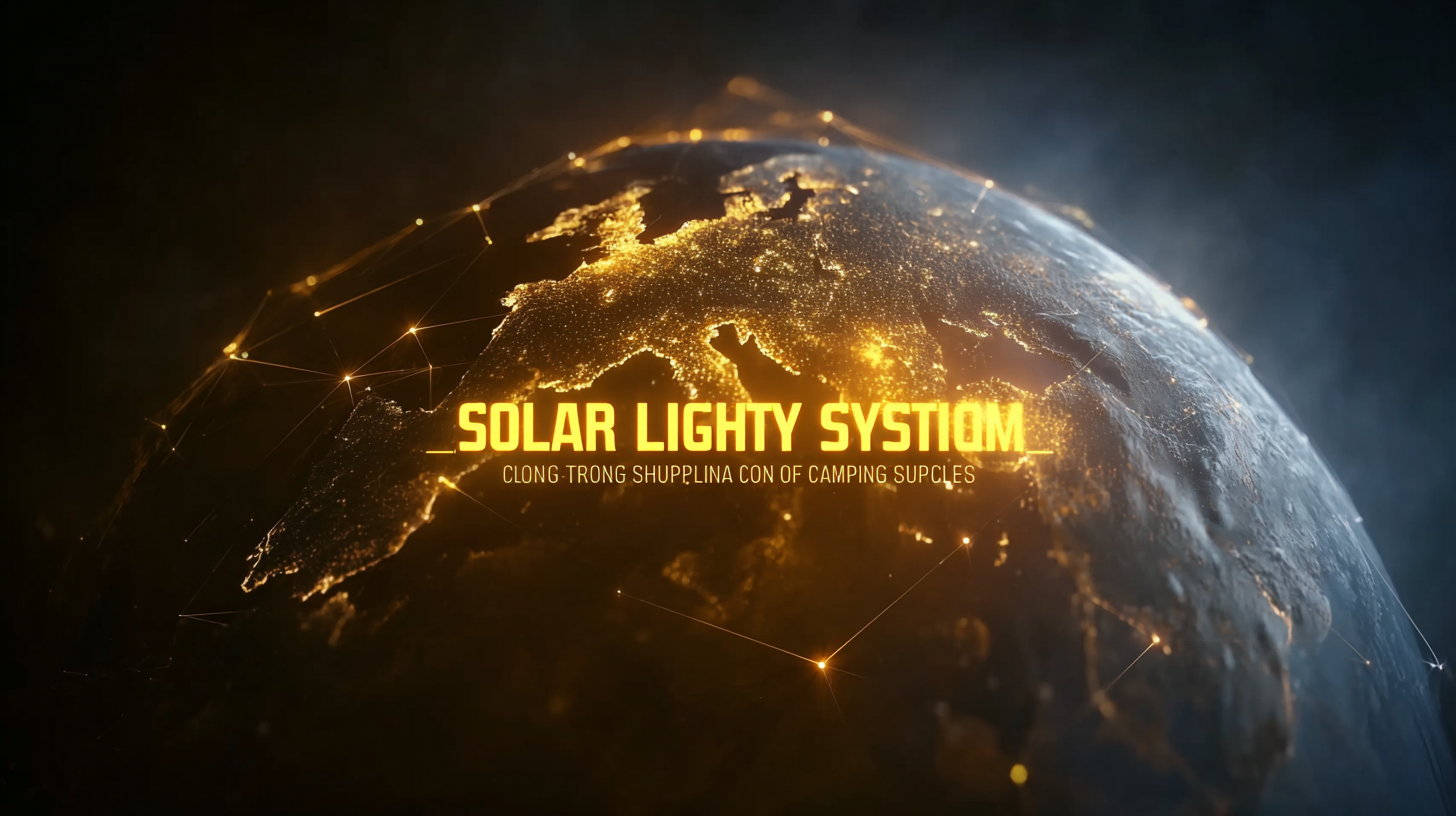How to Harness the 2025 Trends in Solar Lighting Systems for Global Supply Chain Success
The global push for sustainable energy solutions is driving significant advancements in Solar Lighting Systems, which are projected to reach a market valuation of over $8 billion by 2025, according to a report by Allied Market Research. As traditional lighting sources face increasing scrutiny due to their environmental impact, solar lighting alternatives present a viable pathway to energy efficiency. The growth in demand for solar lighting solutions is primarily fueled by urbanization, the need for energy independence, and advancements in technology, such as solar panel efficiency and battery storage. These trends emphasize the importance of understanding the diverse characteristics and applicability of various solar lighting products, ranging from portable lanterns to integrated street lighting systems. For businesses seeking to capitalize on these developments, harnessing the full potential of Solar Lighting Systems within their global supply chain strategy is essential for both competitive advantage and sustainability.

Emerging Solar Lighting Technology Trends to Watch in 2025
As we look ahead to 2025, several emerging trends in solar lighting technology are set to redefine the landscape of sustainable energy solutions. One significant trend is the integration of smart technology into solar lighting systems. With advancements in IoT (Internet of Things), solar lights can now be equipped with sensors that adjust brightness based on environmental conditions, thus enhancing energy efficiency. This not only provides better illumination but also extends the lifespan of the system, making it a cost-effective option for consumers and businesses alike.
Another noteworthy development is the shift toward more aesthetically pleasing designs that incorporate solar technology seamlessly into various environments. Manufacturers are increasingly recognizing the importance of design and functionality, leading to innovations in solar streetlights, garden lights, and architectural lighting. These stylish and functional solutions are proving to be ideal for urban and rural areas, thus expanding the market reach and encouraging wider adoption of solar lighting. The enhanced visual appeal alongside energy savings positions solar lighting as an attractive choice for both residential and commercial applications.
Key Market Drivers Impacting the Solar Lighting Systems Supply Chain
The solar lighting systems market is experiencing a significant transformation, driven by a combination of technological advancements and increasing environmental consciousness. As the global solar generator market is forecasted to grow from $632.74 million in 2025 to $1.02 billion by 2030, understanding the key market drivers becomes crucial for stakeholders in the supply chain. Factors such as government incentives, declining costs of solar technology, and heightened awareness of renewable energy benefits are pivotal in shaping the landscape of solar lighting solutions.
Tip: Leverage government incentives to reduce initial investments in solar lighting systems. Stay updated on local and international trends, as these can provide significant advantages in a rapidly evolving market.
Moreover, the rising demand for sustainable infrastructure across various sectors is accelerating the adoption of solar lighting systems. This growth is further fueled by urbanization and the need for off-grid lighting solutions in developing regions. By addressing these market dynamics, businesses can strategically align their supply chains to capitalize on emerging opportunities.
Tip: Focus on establishing partnerships with reliable suppliers to enhance supply chain resilience. Building a network of trusted collaborators can facilitate smoother operations and ensure quality standards in solar lighting product offerings.

Strategies for Integrating Smart Technology in Solar Lighting Solutions
The integration of smart technology in solar lighting solutions is poised to revolutionize how we harness renewable energy. With the rise of the Internet of Things (IoT), solar lighting systems can now be interconnected, allowing for real-time data collection and monitoring. Such advancements enable users to track energy consumption, optimize battery performance, and adjust lighting levels based on environmental conditions or specific needs. Companies that leverage these smart technologies will not only enhance the efficiency of their solar installations but also increase their appeal to eco-conscious consumers.

Moreover, implementing smart technology in solar lighting contributes to better resource management. For instance, automated sensors can detect ambient light and adjust illumination accordingly, reducing wasteful energy consumption. Additionally, predictive analytics can forecast energy needs based on historical usage patterns, ensuring a consistent and reliable power supply. As the global demand for sustainable solutions grows, businesses that adopt these innovative strategies will position themselves as leaders in the solar industry, driving supply chain success while contributing to a greener future.
Evaluating Cost-Effectiveness and ROI of Solar Lighting Systems
As organizations evaluate the shifting landscape in solar lighting systems, understanding their cost-effectiveness and return on investment (ROI) becomes paramount. With the projected rise in demand for sustainable energy solutions by 2025, investing in solar lighting not only aligns with global sustainability goals but also presents significant savings on energy costs over time. The initial outlay for solar technology installation can appear daunting; however, a comprehensive analysis reveals that these systems can recoup their costs through reduced electricity bills and minimal maintenance expenses.
Moreover, the ROI of solar lighting goes beyond financial metrics. Companies that leverage solar solutions can enhance their corporate image as sustainability leaders, appealing to environmentally conscious consumers and partners. This strategic positioning can open up new market opportunities and create a competitive edge in an increasingly eco-aware business landscape. As the 2025 trends continue to evolve, investing in solar lighting systems represents a forward-thinking approach to not only optimize operational efficiency but also contribute to a greener planet, confirming that the benefits extend well beyond mere cost savings.
Sustainability Practices to Enhance Global Supply Chain Efficiency in Solar Sector
As the global supply chain landscape evolves, the emphasis on sustainability practices in the solar sector is becoming increasingly critical. The transition to renewable energy sources, such as solar power, showcases a practical approach to reducing the environmental impact of logistics operations. By integrating solar lighting systems within supply chains, companies can not only enhance energy efficiency but also respond proactively to regulatory changes that prioritize sustainable practices. This transition not only aligns with environmental, social, and governance (ESG) trends but also offers opportunities for collaboration among supply chain partners committed to green initiatives.
Moreover, as geopolitical risks rise, adapting supply chains to ensure resilience is vital. Implementing solar energy solutions enhances operational stability by reducing dependency on fluctuating fossil fuel markets. This shift fosters a sustainable logistics framework that significantly lowers carbon emissions, particularly in transportation and warehousing—two major contributors to global CO2 output. Companies embracing these innovative strategies will not only navigate uncertainties more effectively but also position themselves as leaders in the sustainable logistics revolution, paving the way for a more efficient and environmentally-conscious supply chain model.
How to Harness the 2025 Trends in Solar Lighting Systems for Global Supply Chain Success
| Trend | Description | Impact on Supply Chain | Sustainability Practice |
|---|---|---|---|
| Smart Solar Solutions | Integration of IoT in solar lighting for real-time monitoring. | Enhanced efficiency and quick issue resolution. | Utilizing predictive maintenance strategies to reduce waste. |
| Eco-friendly Materials | Use of sustainable materials in product manufacturing. | Improved brand image and customer loyalty. | Implementing recycling programs for old units. |
| Energy Storage Innovation | Advancements in battery technology to enhance storage. | Greater reliability and energy distribution efficiency. | Optimizing energy use with smart grid connections. |
| Decentralized Production | Shifting production closer to end-users. | Reduced logistics costs and carbon footprint. | Encouraging local sourcing of components. |
| Regulatory Compliance | Adhering to environmental regulations in solar energy. | Minimized legal risks and enhanced market access. | Implementing audits and certifications for green practices. |
